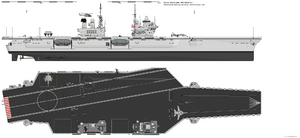Sistine-class aircraft carrier
 Sistine, as in her 2006 deployment.
| |
| Class overview | |
|---|---|
| Builders: |
Whitecap Shipyards Alexandria, |
| Operators: |
|
| Cost: | Classified |
| Built: | 1990-2012 |
| In service: | 1996-present |
| Planned: | 5 |
| Completed: | 5 |
| Active: | 5 |
| General characteristics | |
| Class and type: | Aircraft carrier |
| Displacement: | 87,000 tons, full load |
| Length: | Overall: 330 meters |
| Beam: | Overall: Around 74 meters |
| Draught: | 11 meters |
| Propulsion: |
list error: <br /> list (help) 2 × Central Electric RM-2 reactors 4 × steam turbines, four shafts, 270,000 shp |
| Speed: | In excess of 30 knots |
| Range: | Unlimited |
| Complement: | Around 5,200 including embarked airwing. |
| Sensors and processing systems: |
|
| Electronic warfare & decoys: |
|
| Armament: |
list error: <br /> list (help) |
| Armour: | Kevlar over vital spaces |
| Aircraft carried: | 80 fixed wing and helicopter |
The Sistine-class is a class of nuclear powered aircraft carriers in service with the Meridonian Navy. The ships are named after large Meridonian cities, and are the largest warships ever built for the Meridonian navy. They succeeded the Atlantia-class of aircraft carriers. They were built starting in late 1990, and the first ship. Sistine, was commissioned in 1996, with the final ship of the class, Baymark, commissioning in 2012.
Replacements for the aging Atlantia-class carriers had been planned since at least the early 1980s, but were delayed a multitude of time due to a mixture of budget constraints and emerging design requirements- most notably the integration of the new Common Air Defense Missile system, which was replacing a medley of other air defense missile systems across the Navy by the early 2000s. The Liberal government of 1986 was planning on cancelling the project and replacing the carriers instead with large missile cruisers as the centerpiece capital ship of the Navy, which were seen as cheaper and an effective way to limit long-term military expenditures. This caused an uproar in both Navy command and public opinion when said plans were made public. When five senior admirals and half of the Chiefs of Defense Staff tendered their resignations over the issue and more conservative members of the coalition began to vacate it, a snap election saw the liberal government ousted and replaced by a Federal Party coalition, which immediately reinstated the general officers and the Sistine-class project.
Designed based on lessons learned with the Atlantia-class, the Sistine-class carriers feature a number of new improvements. Most notable of these is an innovative two-island design, originally made to accommodate a separation of funnels when the ship was intended as a non-nuclear carrier, but ported over to the nuclear design due to their improvements in deck space usage, redundancy of systems and command, and operational efficiency. It features a state-of-the-art Broadlight air search radar developed for the Helena-class destroyers, capable of tracking hundreds of targets in real time. It is the first Meridonian capital ship to be nuclear-powered, and features improved facilities for aircraft and munitions handling. Carriers from Kohaku onwards have the M21 CAD/S launching mounts replaced with 8-cell VLS tubes, quadrupling the theoretical total of available anti-aircraft missiles carried, however it is unlikely that these vessels commonly carry that many. The VLS tubes do allow for the integration of standoff anti-submarine rockets and theoretically allow for the integration of ship-based cruise and anti-ship missiles, however the integration of non-defensive ship-based weaponry aboard the Sistine-class carriers has been rejected by the Navy. The Sistine-class is expected to serve until the 2050s at the earliest.
Description
Design
Construction
Propulsion
Armament and protection
Carrier air wing
Flight deck and aircraft facilities
Strike groups
Design differences within the class
Ships in class
| Ship | Pennant number | Laid down | Launched | Commissioned |
|---|---|---|---|---|
| Sistine | R10 | 2 December 1990 | 3 March 1996 | 1 December 1996 |
| Kohina | R11 | 11 April 1993 | 2 March 1998 | 1 March 1999 |
| Kohaku | R12 | 24 May 1996 | 12 August 2002 | 18 September 2003 |
| Marin Bay | R13 | 22 June 2002 | 4 October 2008 | 9 July 2009 |
| Baymark | R14 | 11 August 2005 | 2 December 2011 | 5 November 2012 |
